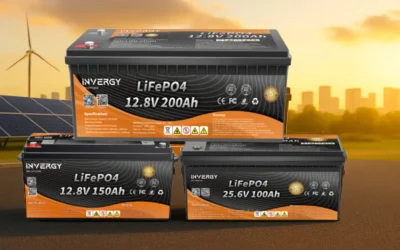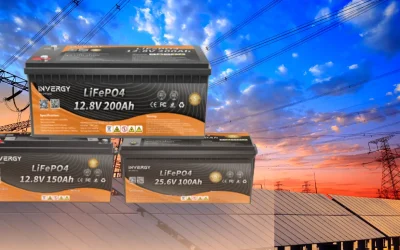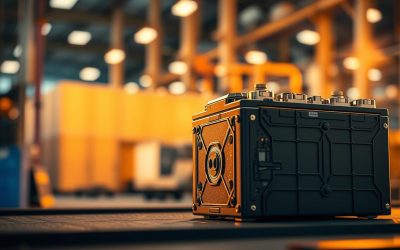The need for energy storage solutions is growing fast. Knowing the lfp battery price is key. This part looks at what makes lfp battery cost change in India. It covers many things that affect how much Lithium Iron Phosphate batteries cost.
By looking at these points, people can make smart choices about buying and using these batteries. This helps them see how cost and performance go hand in hand in this fast-changing area.
Key Takeaways
- LFP batteries are getting more popular because they are efficient and affordable.
- The price changes because of many important factors, so it’s good to stay updated.
- How much power the battery holds is a big factor in its cost.
- How long the battery lasts and smart BMS technology also affect prices.
- Knowing about GST can help plan your budget for buying batteries.
- Watching the market and future trends helps predict price changes.
Understanding LFP Batteries
LFP battery technology is a big step forward in energy storage. It’s different from other batteries because of its special makeup and how it works. Unlike lithium-ion batteries that use cobalt, LFP batteries use lithium iron phosphate. This makes them safer and less likely to catch fire.
LFP batteries also last longer. They can handle many charge-discharge cycles, which saves money in the long run. They work well in electric cars and for renewable energy, making them very useful.
As we care more about the environment, LFP batteries become even more important. They don’t need toxic materials, which makes them better for the planet. This helps in making cleaner energy and easier recycling, showing their role in green energy.
Key Factors Affecting LFP Battery Price
To understand LFP battery prices, we must look at several important factors. These factors affect both the cost and what buyers choose. Key ones include production costs, like labor, machinery, and factory expenses. Each part adds to the total cost, shaping the LFP battery cost analysis.
Raw material prices also play a big role in battery costs. Lithium, iron, and phosphates are key for making LFP batteries. Changes in these material prices can affect the whole supply chain, leading to higher retail prices. Market demand is another factor; as electric vehicles and renewable energy systems grow, prices may change.
Technological advancements can bring both new ideas and price changes. Better production methods can make batteries cheaper and better, leading to more competitive prices. Government policies and regulations also impact these prices, like in India where policies can change manufacturing costs.
Looking at the competitive market, companies keep checking these factors to stay competitive. As we learn more about these connections, buyers can make better choices when buying LFP batteries.
Capacity: The Driving Force Behind Price
Understanding battery capacity is key for those looking at LFP batteries. It shows how much energy a battery can store, measured in ampere-hours (Ah) or watt-hours (Wh). A bigger capacity means more energy over time, affecting performance in many areas. This is why it’s so important when looking at LFP battery specs.
Definition of Capacity
Battery capacity tells us how much electricity a battery can hold. It’s a critical factor when checking LFP battery specs. It shows how long a battery can power devices or systems before needing a recharge. A higher capacity means you can use it for longer without needing to recharge it often.
Impact on Usage and Cost
The link between battery capacity and cost is clear. Bigger capacity batteries cost more because they can store and give out more energy. People often think about how much they want to spend versus how much capacity they need. For example, if you need a battery to last a long time, spending more on a bigger capacity battery might be worth it.
| Battery Type | Typical Capacity (Ah) | Cost Range (INR) | Use Case |
|---|---|---|---|
| LFP Battery 100Ah | 100 | 20,000 – 25,000 | Electric scooters |
| LFP Battery 200Ah | 200 | 35,000 – 45,000 | Solar energy storage |
| LFP Battery 400Ah | 400 | 60,000 – 80,000 | Electric vehicles |
Cycle Life and Its Economic Implications
Understanding cycle life is key to seeing the economic side of LFP batteries. Cycle life is how many times a battery can charge and discharge before losing a lot of capacity. It shows how long a battery will work well.
What is Cycle Life?
Cycle life shows how durable a battery is. It tells us how many times it can be charged and discharged before losing too much power. For LFP batteries, this is very important. It affects how reliable they are for things like electric cars and storing energy from the sun.
A battery with a long cycle life doesn’t need to be replaced as often. This makes it more cost-effective over time.
Relationship Between Cycle Life and Price
The link between cycle life and price is clear. Batteries that last longer are usually more expensive at first. But, they cost less in the long run, which is important for things like electric cars and solar energy storage.
When buying batteries, people think about the initial cost and how much they’ll save later. Knowing this helps make smart choices about energy solutions.
Smart BMS: The Value Addition
Battery Management Systems (BMS) are key to how well lithium iron phosphate (LFP) batteries work and last. They keep an eye on the battery’s health, make it perform better, and keep it safe. Smart BMS add more smarts to these tasks, making batteries work even better.
Overview of Battery Management Systems
A good BMS has important parts like sensors, control circuits, and ways to talk to other systems. These parts watch the battery’s voltage, temperature, and how fast it’s charging. This info helps decide how to use the battery safely and make it last longer.
How Smart BMS Affects Pricing
Adding smart features to BMS changes how much LFP batteries cost. Smart BMS make charging better and predict how much energy will be used. Even though they cost more at first, they can save money in the long run by working better and needing less upkeep.
Safety Standards and Certification Costs
Safety standards in LFP battery manufacturing are very important. They make sure batteries work safely and well. This reduces risks from possible failures. It’s key for manufacturers to follow these rules to protect consumers and build trust.
Importance of Safety Standards
Stringent safety standards are vital for LFP batteries. They include tests for heat and mechanical strength to avoid problems. Following these standards helps make reliable products that meet customer and regulatory needs. Safety is key because battery issues can cause big financial losses and harm a brand’s reputation.
Certification Processes and Their Impact on Cost
Getting certifications for LFP batteries means a lot of testing and checks. These steps make sure products are safe, following different rules in different places. While it costs money, it’s worth it for quality and safety. The cost of getting certified is usually passed on to the buyer, affecting prices in the market.
Warranty Factors in Battery Pricing
When you buy LFP batteries, knowing about warranties is key. The battery warranty meaning is what manufacturers promise about their products’ performance and life span. Different warranty types offer varying levels of protection and terms. These can greatly affect the price of batteries.
Meaning of Warranty in Battery Terms
A warranty is a deal between you and the maker. It outlines what the battery should do and who’s responsible if it doesn’t. It might cover replacing or fixing the battery if it fails within a certain time. Knowing what a battery warranty meaning is can help you judge a battery’s quality and dependability.
How Warranty Influences Customer Perception
A good warranty can make a big difference in how people see a battery brand. When looking at warranty types, customers often choose ones with broad coverage and clear rules. A strong warranty can make customers feel more confident in their choice, which can sway their decision to buy a certain LFP battery. Brands with extended, clear warranties are often seen as more reliable, giving them an advantage in the market.
Cycle Count: A Critical Pricing Component
The cycle count of a battery is key to its lifespan and performance. It shows how many times a battery can be charged and used before it loses a lot of power. A higher cycle count means the battery lasts longer and works better, which can make it more expensive.
When looking at prices, makers must think about cycle count’s effect on costs and demand. A battery with a high cycle count might cost more because it lasts longer. People are willing to pay more for batteries that are reliable and last a long time.
By improving battery cycle counts, makers can show their products are a smart choice over time. This appeals to those who care about the environment. Highlighting these points can help businesses stand out in a crowded market.
Impact of GST on LFP Battery Price
The Goods and Services Tax (GST) in India has changed many markets, including LFP batteries. It’s important to understand how this tax works. This is key for both makers and buyers to see how it affects prices.
As a value-added tax, GST in India makes tax simpler. It aims to make prices fair for all products.
Understanding GST in India
GST in India is a big indirect tax that replaces many old taxes. It makes tax collection easier. This helps businesses by making prices clear.
For LFP battery makers, GST changes their costs. This affects what buyers pay.
How GST Influences Overall Pricing
The GST on LFP batteries affects prices in many ways. The tax rates matter a lot. Changes in GST can change what buyers pay.
This tax system makes things clearer. It helps buyers make better choices. It also pushes makers to follow tax rules well.
Market Demand and Supply Dynamics
The LFP battery market in India is changing fast. Many things affect prices. It’s key for everyone to understand these changes.
More people and businesses are moving to electric vehicles and green energy. This shift changes how we see prices.
Current Trends in LFP Battery Market
Several important factors are shaping the LFP battery market in India. The push for green energy and electric cars is making demand go up. Key factors include:
- More government support for electric vehicles.
- More people caring about the environment.
- Better technology in making batteries.
- More money coming in from investors.
Impact of Supply Chain on Pricing
The supply chain is very important for LFP battery prices. Things like raw materials, making costs, and shipping affect prices. A smooth supply chain means better prices. But, problems can make prices go up.
- Costs go up when materials are hard to find.
- It takes longer to make and deliver batteries.
- Prices go up as companies deal with higher costs.
Understanding these points helps consumers and businesses. Staying updated on trends and market conditions helps make better choices. This benefits everyone.
| Factor | Impact on Demand | Impact on Supply Price |
|---|---|---|
| Government Incentives | Increase | Stable |
| Technological Advancements | Increase | Decrease |
| Raw Material Availability | Fluctuate | Increase |
| Consumer Awareness | Increase | Stable |
Future Trends in LFP Battery Pricing
The world of LFP battery pricing is set for big changes. New tech and shifting market trends will play big roles. As companies invest in research, we’ll see new materials and ways to make batteries. This will make things better for everyone.
Technological Advancements
Technologists are working hard to make LFP batteries better. They want to pack more energy and make them cheaper. By using new materials and making batteries in new ways, they aim to make them last longer and work better.
Predicted Market Changes
As more people want electric cars and green energy, the LFP battery market will change fast. Government help and the push for green living will affect prices. With more companies competing and a focus on making batteries in parts, the market will get even more exciting.
Invergy LFP Batteries: Reliable and Cost-Effective
At Invergy Power Supply, we provide Lithium Iron Phosphate (LFP) batteries engineered for both performance and affordability. Designed with a long cycle life, smart BMS integration, and certified to meet strict safety standards, our batteries are ideal for applications ranging from solar energy storage to electric vehicles and industrial backup power.
Backed by robust warranty options and efficient after-sales support, Invergy LFP batteries deliver dependable energy storage while reducing overall lifecycle costs. Whether you are planning for residential, commercial, or industrial use, Invergy ensures you get maximum value and reliability from your energy investment.
Conclusion
We’ve looked at what affects LFP battery prices, like capacity and cycle life. We also talked about smart BMS, safety standards, and warranties. GST and supply and demand are also key factors.
Each of these elements is important for understanding LFP battery costs. This knowledge helps people make better choices when buying batteries.
The LFP battery market is always changing. New technologies and what people want are driving these changes. It’s important to watch these trends if you’re interested in the field.
Looking ahead, we need to stay flexible in this fast-changing world. This ensures we meet the needs of our customers.
Understanding LFP battery pricing helps consumers make smarter choices. It also helps in the bigger conversation about green energy. The balance between supply and demand will shape the future of this important industry.




0 Comments